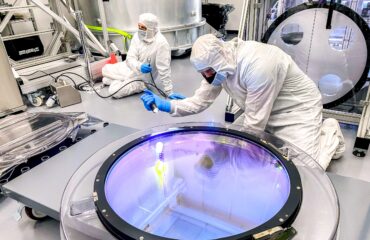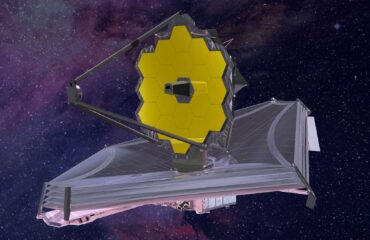One step closer: using telescopes to reveal the mystery behind lightning initiation
Lightning is a naturally occurring, very powerful electrical discharge that has intrigued humans since ancient times. It can sometimes be seen during thunderstorms, in heavy snowstorms, on the surface of volcanic eruptions, and during nuclear detonations. The most common, however, typically occurs inside thunderstorms. Bolts of lightning can end in disaster, and we are well aware, yet how they form in the first place has puzzled scientists for centuries. Not surprisingly, this natural phenomenon was often presented in mythological contexts that attributed it to the power of deities. Today, the more broadly accepted scientific theory posits that the movement of hail and ice crystals inside a thundercloud creates an electrical field that grows and results in lightning. But we had not been able to see this process… until now.
Researchers have long tried to observe this electrical phenomenon in thunderstorms, but such studies carry several challenges, from the limitation of cameras in capturing the precise moment of initiation inside the opaque clouds, to the potential interference that electrical instruments inside the clouds may generate in the data. Scientists have sent weather balloons, rockets, and airplanes into storms to take snapshots of the interior of thunderclouds but have never found electrical fields large enough to originate such gigantic discharges. But a “lucky” event might have finally solved the mystery.

Lightning lights the sky
In 2018, in the Netherlands, a bolt of lightning happened in just the right place for researchers to properly observe the phenomenon and have a look inside the clouds at the precise moment. The lightning bolt flashed directly above a state-of-the-art network of radio telescopes. The Low-Frequency Array (LOFAR) is a network of thousands of small radio telescopes originally built for gazing at distant galaxies and exploding stars. But when thunderstorms limit astronomical observations, the telescope is used for detecting radio pulses that emanate from lightning flashes.
Radio detectors have been used to map lightning events for some time, but usually, their images are low-resolution and only two-dimensional. When the lightning flashed above the latest-generation LOFAR detector, however, the quality of the data collected was very distinct. The telescope network maps lightning in detail in three dimensions, and at speeds 200 times faster than previous instruments. A research team at LOFAR recently finished analyzing the measurements made during the lightning, and now we may have the first clear picture of what happens inside thunderstorms.

LOFAR.
The results were recently published in the journal Geophysical Research Letters, by Christopher Sterpka, a graduate student from the University of New Hampshire, and co-authors from the University of Groningen, Radboud University Nijmegen, Netherlands Institute for Radio Astronomy, and Erlangen Center for Astroparticle Physics. The paper aimed at settling a long-standing debate on the field. As it turns out, these types of lightning events do start inside thunderclouds and these detailed observations revealed that electrical fields grow strong enough for bolts to initiate, intensify, and propagate to the ground.
The radio pulses analyzed by Sterpka and colleagues emanated from a 70-meter-wide region deep inside the storm cloud. Their observations provided support for the ice crystals theory, in opposition to its rival theory that cosmic rays were responsible for strengthening electrical fields. The more common type of lightning really starts with clusters of ice crystals inside a cloud, they concluded.
“This theory posits that “the movement of large showers of energetic particles produced by high-energy cosmic rays—which originate from exploding stars halfway across the galaxy—might provide a conductive path that initiates lightning”. Scientific American.
When these ice crystals collide with enough turbulence, one end of each crystal becomes positively charged and the other negatively charged. Electrons are drawn to the positively charged end, first from nearby air molecules and then from air molecules farther away. This generates several ribbons of ionized air, in which initially neutral air molecules become electrically charged. These are called streamers, which extend from the crystal tips. These streamers heat the air by continuously stealing electrons from air molecules, until it becomes sufficiently hot and conductive and ends in lightning.
At first, a streamer (called the pilot) moves down from the negatively charged center of the cloud and is followed by a more powerful current called the “stepped leader”, creating a path of ionized air. This ionized path triggers a current of high density, called the “return streamer”, that moves from the positively charged ground towards the stepped leader. Lightning bolts strike when the return streamer meets the “dart leader”, generating a powerful discharge of a second negatively charged center in the thundercloud.
“After the first stroke (initiated by a stepped leader), the dart leader (or continuous leader) typically initiates each succeeding stroke of a multiple-stroke flash lightning.” American Meteorological Society.

Visual representation of lightning initiation.
The paper has received some critiques, though, since it does not indicate how the lightning starts, as we do not directly observe ice particles ionizing the air but only the conditions that allow for the process to start and its immediate consequences. This is the point made by Dr. Ute Ebert, a physicist at the Eindhoven University of Technology in the Netherlands, who nonetheless acknowledges the significance of the findings. She points out that while we still do not know where the first electron comes from or how the discharge starts near an ice particle, LOFAR’s observations may help build accurate lightning models and simulations. According to her, it is possible, for instance, that ice crystals do not explain the entirety of the phenomenon and cosmic rays could still play a secondary role in triggering the first streamers. Sterpka and colleagues are compiling more data and are hopeful they will be able to see the initiation process at the very beginning when the first sparks are generated by the ice crystals.
Bolts of lightning are gigantic electrical phenomena that have affected and frightened humans for a long time. As often occurs with the unknown, several cultures have provided mythical explanations for it, and even today there is still a lot of mystery around them: How do they propagate? How do they grow? How do they connect to the ground? But, as time goes on, we become closer to answering these questions, and as far as the team at LOFAR is concerned this will happen sooner than later.



